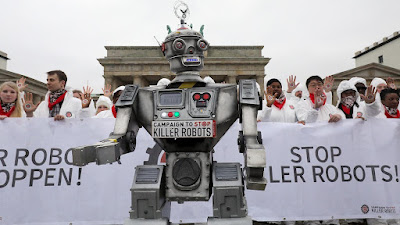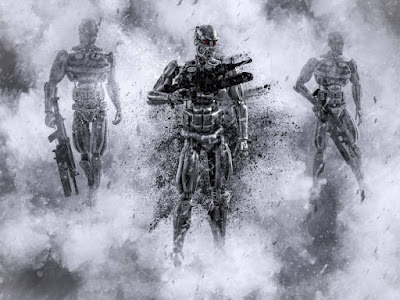The Campaign to Stop Killer Robots is a non-profit
organization devoted to mobilize and campaign against the development and deployment of deadly autonomous
weapon systems (LAWS).
The campaign's main issue is that armed robots making
life-or-death decisions undercut legal and ethical restraints on violence in
human conflicts.
Advocates for LAWS argue that these technologies are
compatible with current weapons and regulations, such as cruise missiles that
are planned and fired by humans to hunt out and kill a specific target.
Advocates also say that robots are completely reliant on
people, that they are bound by their design and must perform the behaviors that
have been assigned to them, and that with appropriate monitoring, they may save
lives by substituting humans in hazardous situations.
The Campaign to Stop Killer Robots dismisses responsible
usage as a viable option, stating fears that the development of LAWS could
result in a new arms race.
The advertisement underlines the danger of losing human
control over the use of lethal force in situations when armed robots identify
and remove a threat before human intervention is feasible.
Human Rights Watch, an international nongovernmental
organization (NGO) that promotes fundamental human rights and investigates
violations of those rights, organized and managed the campaign, which was
officially launched on April 22, 2013, in London, England.
Many member groups make up the Campaign to Stop Killer
Robots, including the International Committee for Robot Arms Control and
Amnesty International.
A steering group and a worldwide coordinator are in charge
of the campaign's leadership.
As of 2018, the steering committee consists of eleven
non-governmental organizations.
Mary Wareham, who formerly headed international efforts to
ban land mines and cluster bombs, is the campaign's worldwide coordinator.
Efforts to ban armed robots, like those to ban land mines
and cluster bombs, concentrate on their potential to inflict needless suffering
and indiscriminate damage to humans.
The United Nations Convention on Certain Conventional Weapons (CCW), which originally went into force in 1983, coordinates the worldwide ban of weapons.
Because the CCW has yet to agree on a ban on armed robots,
and because the CCW lacks any mechanism for enforcing agreed-upon restrictions,
the Campaign to Stop Killer Robots calls for the inclusion of LAWS in the CCW.
The Campaign to Stop Killer Robots also promotes the
adoption of new international treaties to implement more preemptive
restrictions.
The Campaign to Stop Killer Robots offers tools for
educating and mobilizing the public, including multimedia databases, campaign
reports, and a mailing list, in addition to lobbying governing authorities for
treaty and convention prohibitions.
The Campaign also seeks the participation of technological
businesses, requesting that they refuse to participate in the creation of LAWS
on their own will.
The @BanKillerRobots account on Twitter is where the
Campaign keeps track of and broadcasts the names of companies that have pledged
not to engage in the creation or marketing of intelligent weapons.
~ Jai Krishna Ponnappan
You may also want to read more about Artificial Intelligence here.
See also:
Autonomous Weapons Systems, Ethics of; Battlefield AI and Robotics; Lethal Autonomous Weapons Systems.
Further Reading
Baum, Seth. 2015. “Stopping Killer Robots and Other Future Threats.” Bulletin of the Atomic Scientists, February 22, 2015. https://thebulletin.org/2015/02/stopping-killer-robots-and-other-future-threats/.
Campaign to Stop Killer Robots. 2020. https://www.stopkillerrobots.org/.
Carpenter, Charli. 2016. “Rethinking the Political / -Science- / Fiction Nexus: Global Policy Making and the Campaign to Stop Killer Robots.” Perspectives on Politics 14, no. 1 (March): 53–69.
Docherty, Bonnie. 2012. Losing Humanity: The Case Against Killer Robots. New York: Human Rights Watch.
Garcia, Denise. 2015. “Killer Robots: Why the US Should Lead the Ban.” Global Policy6, no. 1 (February): 57–63.







